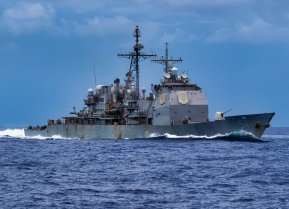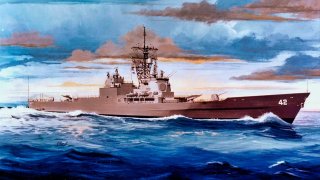The Navy's Virginia-Class Nuclear-Powered Cruisers Were Oozing with Firepower
Although the Virginia-class vessels are no longer in active service with the U.S. Navy today, the service still requires the function of cruisers.
Virginia-Class Cruiser of Cold War - An Explainer: Years back, the word cruiser was routinely applied to frigates operating in the sailing era. Since these small vessels were quicker and lighter than bigger battleships, these cruisers could more easily traverse the seas and locate incoming enemy fleets and convoys. By the outbreak of World War I, however, cruisers as large as battleships began to hit the waters, equipped with scores of armaments. Designated as “battle-cruisers” for the sheer number of weapons operated from within these ships, these vessels largely served as part of militaries’ air-defense screens protecting aircraft carrier groups.
During the Cold War, the U.S. Navy commissioned four Virginia-class nuclear-powered guided-missile cruisers amidst rising tensions between Washington and the Soviet Union. For almost fourteen years, these double-ended guided ships would become the final class of nuclear-powered cruisers. Although the Virginia-class was formidable armament-wise, various flaws led to their very short service lives.
Origin Story of the Virginia-Class Cruisers:
The Virginia-class nuclear cruisers were derived from the earlier California-class.
Between the mid-1970s and 1998, two California-class ships were operated by the Navy. Like many of its counterparts, this class of vessels could steam for years between refueling.
Some distinguishing characteristics between the California-class and its predecessors included its lack of helicopter hangers. Two ships in this class were developed, and while a third was conceptualized, the incoming Virginia class was considered more advanced, rendering the California-class ships as second fiddle.
When the Virginia-class cruisers were commissioned, they immediately became ideal escorts for the Navy’s fast nuclear-powered aircraft carriers like the Nimitz-class.
The ships’ superb flagship facilities, including anti-submarine and surface-to-surface warfare capabilities, made them a critical component of the service’s sea-based apparatus.
The Virginia class cruisers were designed to carry one LAMPS helicopter aft. This unique arrangement was an enhancement over the preceding California-class, which only possessed a landing pad aft with basic refueling capabilities.
Initially, the Navy planned to sail eleven ships in the Virginia-class. However, only four of these cruisers were ever constructed, and the rest of the class was canceled.
Prior to their retirement, Virginia-class ships underwent a refit:
As more technology was introduced to the Navy over the years, the Virginia-class cruisers underwent one major refit to retain their edge over competitors.
When this refit occurred in the late 1980s, the cruisers received the SM-2 MR (RIM-66J) SAM that replaced the SM-1, as the former had an almost double range.
Additionally, two Phalanx close-in weapon systems, Harpoon launchers, and Tomahawk cruise missiles were incorporated into the cruisers.
Further details have been explained by Naval Analyses:
“The Tomahwak missiles were installed after a decision was taken to remove the helicopter from the ships' equipment as the Virginias were encountering problems with the elevators and in keeping the hangars watertight. Therefore, the capability of the ships to carry a Kaman SH-2 Seasprite LAMPS (Light Airborne Multipurpose System) helicopter either in the hangar or stationed at the deck, it was eliminated. Their electronics and sensors also were upgraded or replaced by more modern ones (such as the AN/SPS-49 radar, although USS Virginia kept the older AN/SPS-40).”
Virginia-class cruisers came with a hefty price tag:
When the Cold War dissipated following the collapse of the Soviet Union, all four Virginia-class cruisers were decommissioned form the Navy-despite their intended service lives of 38 years. These ships were expensive to construct and maintain and the Navy’s budget after the Cold War was smaller.
According to the 1996 Navy Visibility and Management of Operating and Support Costs (VAMOSC) study, the annual cost of maintaining a Virginia-class cruiser lingered around $40 million. Comparably, the cost to operate and maintain an Arleigh Burke-class destroyer was half that cost.
Today, analysts and industry experts believe the Virginia-class cruisers were relegated to retirement too soon. In fact, the critical electronics upgrade incorporated into these ships would have been an asset today to counter modern threats.
While the cruisers could pack quite the punch, they were unable to carry the SM-2ER long-range surface-to-air missile, which seriously diminished their capabilities.
Although the Virginia-class vessels are no longer in active service with the U.S. Navy today, the service still requires the function of cruisers. As detailed by the Commander, Naval Surface Force Atlantic (SURFLANT), “Modern U.S. Navy guided-missile cruisers perform primarily in a Battle Force role. These ships are multi-mission Air Warfare (AW), Undersea Warfare (USW), Naval Surface Fire Support (NSFS) and Surface Warfare (SUW) surface combatants capable of supporting carrier battle groups, amphibious forces or operating independently and as flagships of surface action groups. Cruisers are equipped with Tomahawk cruise missiles giving them additional long range strike warfare capability. Some Aegis Cruisers have been outfitted with a Ballistic Missile Defense (BMD) capability.”
About the Author
Maya Carlin is an analyst with the Center for Security Policy and a former Anna Sobol Levy Fellow at IDC Herzliya in Israel. She has by-lines in many publications, including The National Interest, Jerusalem Post, and Times of Israel. You can follow her on Twitter: @MayaCarlin.
All images are Creative Commons. Image is of a Virginia-Class in proposed AEGIS configuration.


